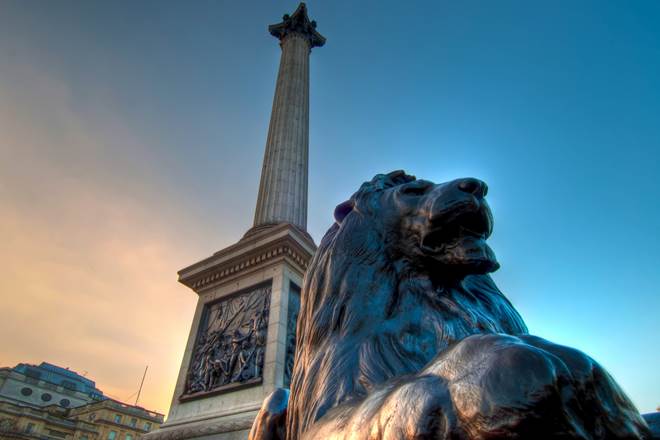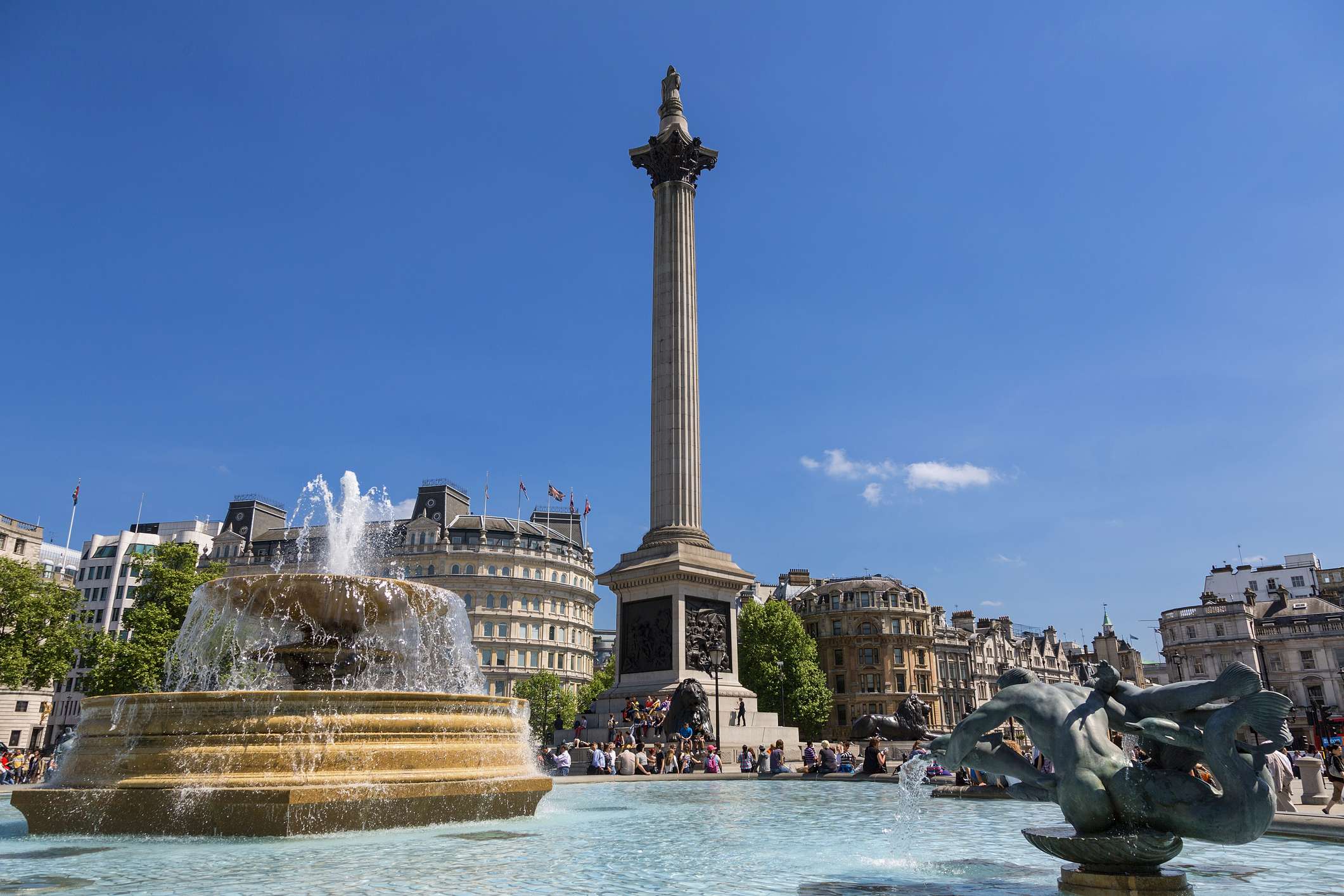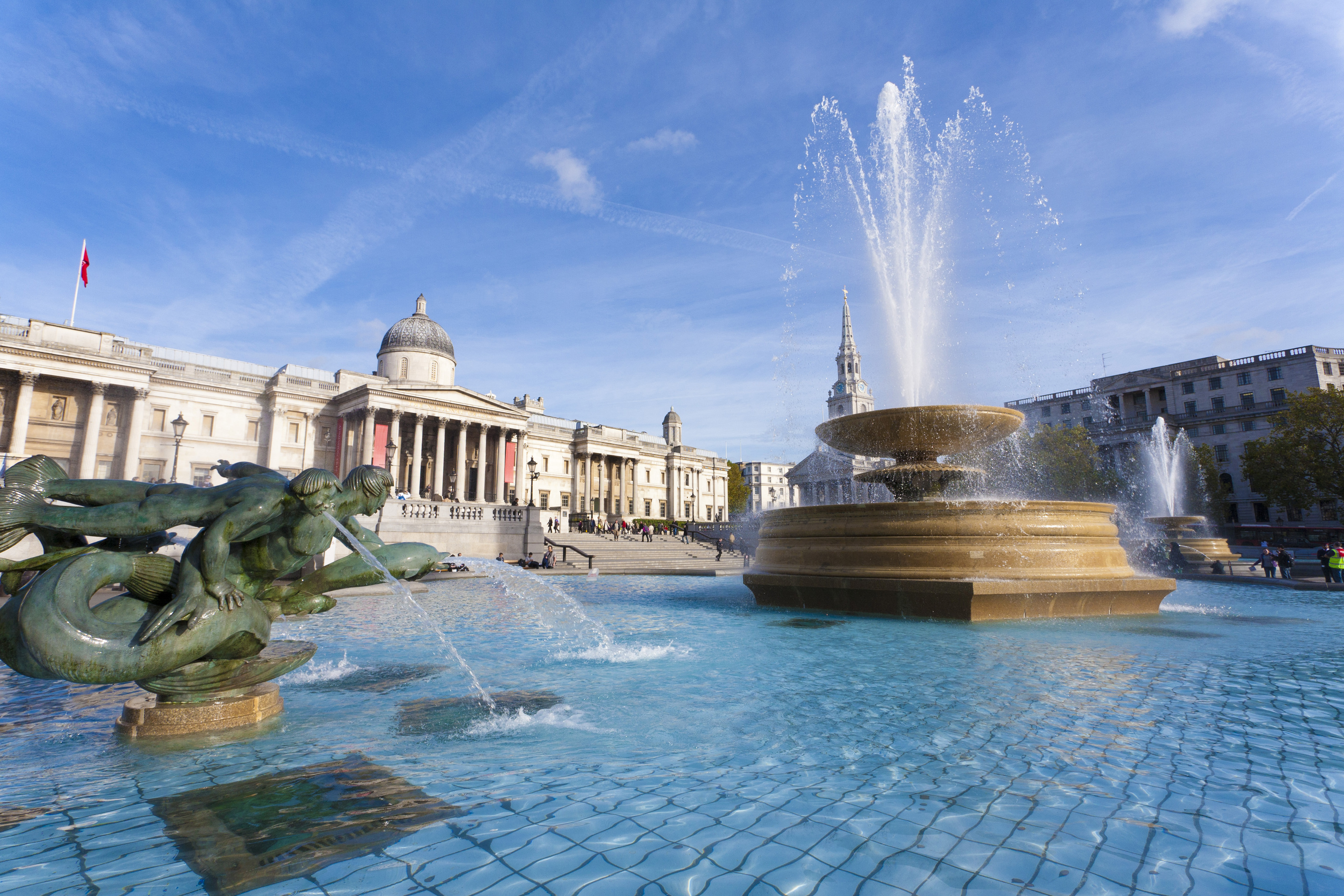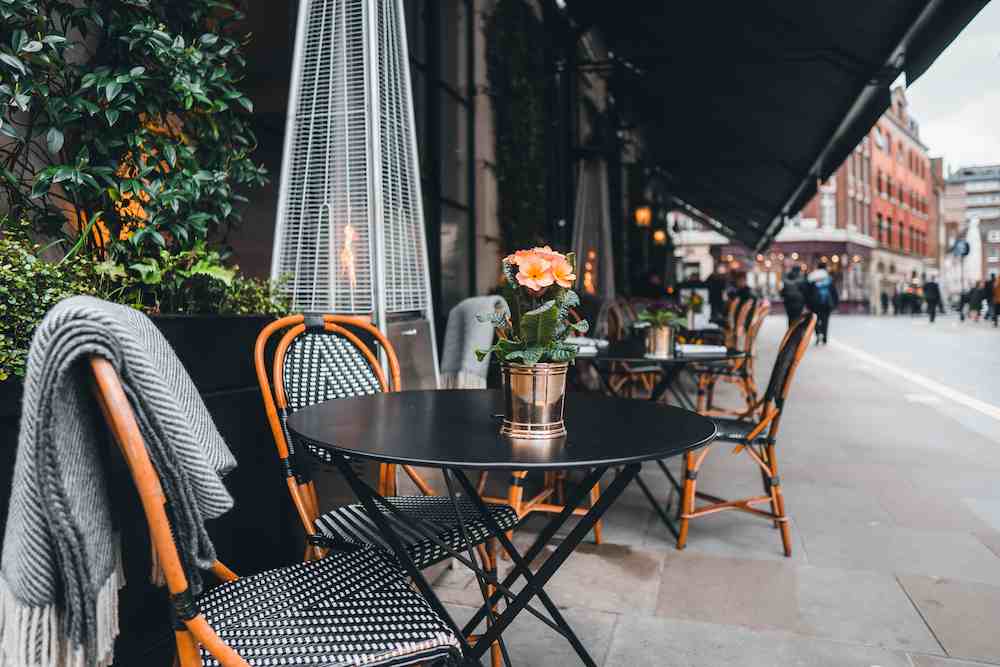Trafalgar Square was established in the early 19th century, serving the people of London as a hub for meetings, rallies and protests, entertainment and events throughout its long history. Today, it’s a favourite spot among tourists, who head there to see its famous column, fountains and lions, and visit nearby attractions.
What’s in this guide?
- What to see in Trafalgar Square
- Trafalgar Square history and facts
- Restaurants, bars and shops nearby
How to get to Trafalgar Square
Trafalgar Square is surrounded by museums and galleries, entertainment venues, shops and historic buildings. There’s a good chance you’ll visit Trafalgar Square during any trip to London. But how do you get there?
Charing Cross station is the nearest train station to Trafalgar Square. You’ll be there in just 3 minutes on foot when you take a train here. You can also ride an underground train (tube) to Charing Cross; it’s on the Bakerloo (brown) and Northern (black) lines.
The Embankment tube station is also close to Trafalgar Square. This stop is served by the District (green) and Circle (yellow) lines, plus Bakerloo and Northern.
Closer to the Piccadilly line (dark blue)? You could take the tube to Piccadilly Circus station, a couple of minutes’ walk from the famous square, or to Leicester Square, which is served by Piccadilly and Northern line services.
What to see in Trafalgar Square
Trafalgar Square is home to iconic statues and fountains, not to mention the towering Nelson’s Column, which stands proudly at its centre. It’s also surrounded by museums and galleries, cultural spaces and historic buildings. Don’t miss a thing!
Nelson’s Column
Nelson’s Column is probably the most famous Trafalgar Square monument, designed and built to honour Admiral Nelson after his victory in the Battle of Trafalgar in 1895.
The five-metre column is made from granite, carved by E. H. Baily. The bronze platform it stands on is made from the melted-down guns from the Woolwich Arsenal Foundry, a fitting base for this honorary war monument. Four bronze panels at the column’s base depict Nelson’s most triumphant battles.
Statues
When thinking of Trafalgar Square, many of us imagine the giant bronze lions, which are there to protect Nelson’s Column. The four famous lion statues are placed around the base of the column, commonly known as the Landseer Lions after the artist who made them.
Edward Landseer, known for his paintings of dogs and horses, was commissioned to design the lions in 1858. He had made paintings of lions but had never sculpted before. He accepted the job and worked carefully on the statues, taking four years to sketch the animals before turning to sculpture. The first lion was completed in 1866, and the fourth finished in 1867, nine years after Landseer’s commission!
The Landseer Lions are some of the most giant bronze statues in England. But the immense size of Nelson’s Column means they can seem small in photographs.
Fountains
There are two fountains in Trafalgar Square, added in 1845, while the mermaids, dolphins and tritons were added later.
Many people don’t realise that the fountains we know and love are not the originals! The first fountains in Trafalgar Square were designed by Sir Charles Barry (also responsible for Big Ben and Westminster Palace), fed by water from a well behind the National Gallery. The water system needed improvement, so a new pump and two new fountains were commissioned in the late 1930s.
The fountains we know today were designed by Sir Edward Lutyens but fitted into Barry’s original basins. They were unveiled in 1948 by Prince Richard, Duke of Gloucester.
The Fourth Plinth
The Fourth Plinth is the most recent addition to Trafalgar Square, added in 1998. It’s a platform for changing contemporary artworks, bringing installations to Londoners and tourists in Trafalgar Square. It’s become famous worldwide for its diverse displays, commenting on historical and modern issues.
The Fourth Plinth highlights include:
- Yinka Shonibare CBE’s Nelson’s Ship in a Bottle, raising British colonialism and the diverse London culture that followed
- Katharina Fristch’s Hahn/Cock, commenting on masculine posing
- Michael Rakowitz’s The Invisible Enemy Should Not Exist, which highlighted the legacy of the Iraq War and Middle Eastern culture in the UK
The National Gallery
The National Gallery is one of the best art galleries in London, set in Trafalgar Square, home to over 2,300 paintings. The collection spans from the mid-13th-century to 1900 and includes many masterpieces you might recognise.
Highlights in the National Gallery include Rembrandt’s Self Portrait at the Age of 34, Van Gogh’s Sunflowers, Michelangelo’s The Entombment (or Christ being carried to his Tomb and Turner’s The Fighting Temeraire.
Admiralty Arch
Admiralty Arch is a London landmark on the edge of Trafalgar Square. It was commissioned by King Edward VII to commemorate Queen Victoria’s death, designed by Sir Aston Webb and completed in 1912. It stands at the northwest end of The Mall, famously passed through by processions including royal weddings, coronations and funerals.
The building was sold in 2012. Westminster City Council agreed on plans to turn Admiralty Arch into a new luxury hotel, private residences and members club.
St Martin-in-the-Fields
Another historical jewel, St Martin-in-the-Fields sits in the corner of Trafalgar Square. This 18th-century church is an example of exquisite architecture, changing its function in response to changing times.
St Martins remains a place where people of different faiths can pray together. The church also hosts live music and events throughout the year.
Trafalgar Square history and facts
Trafalgar Square has played a significant role in London life since the 13th century, although it was given its name in 1830. In its time, the famous space has seen royal processions, protests, events and many pigeons come and go. It’s a perfect meeting place for East and West Londoners to come together!
Bloody Sunday
One of the most famous demonstrations in Trafalgar Square happened on what’s now known as Bloody Sunday in 1887. The event was organised by the Social Democratic Federation and the Irish National League, a march against unemployment in Ireland.
At least 10,000 protestors and 3,000 spectators arrived in the square from all directions. More than 2,000 police and troops were deployed, resulting in riots. For many activists, Bloody Sunday is remembered as an example of violent repression.
Anti-war marches
Trafalgar Square has also hosted many anti-war demonstrations over the years, with protestors rallying against war and nuclear weapons. In 1968, around 10,000 people gathered to protest the US involvement in the Vietnam War, marching from Trafalgar Square to the American Embassy. Anti-war protestors also joined to demonstrate against the Afghanistan War and the Iraq War.
Restaurants, bars and shops near Trafalgar Square
As a Central London hub, it should be no surprise that Trafalgar Square is surrounded by many of the city’s best restaurants, bars, pubs and shops. Not to mention entertainment venues in the nearby West End, or ‘Theatreland’.
Restaurants and cafés
Fancy a bite to eat while you’re in the area? There’s plenty to choose from here, whether you’re looking for breakfast or lunch, brunch, dinner or a late-night snack. Trafalgar Square is also very close to China Town, Covent Garden and Soho, home to some of London’s best eateries!
- Ave Mario
- Petersham Nurseries
- Kebab Queen
- Nutshell
- The Barbary
- Spring Restaurant
- Red Farm
- Café TPT
- C&R Café
- Dumplings Legend
Or why not grab a quick coffee and take the weight off your feet? There are lots of great coffee shops around:
- Abuelo
- Chez Antoinette
- Covent Garden Grind
- Lilly’s Café
- The Gentleman Baristas
Bars and pubs
If you fancy a quick pint or a few cocktails while you’re in the Trafalgar Square area, you’re in luck! Many of the city’s best traditional pubs and sleek, luxurious cocktail bars are nearby.
- The Admiralty
- Garrick Arms
- The Bear and Staff
- The Marquis
- The Cambridge
- The Moon Under Water
- The Rooftop
- Rockwell
- Old Shades
Shops
For a spot of retail therapy near Trafalgar Square, head into nearby Covent Garden and Soho. These are two of London’s best shopping areas, home to many high street favourites, independent brands and vintage gems.
Trafalgar Square opening times and prices
Since Trafalgar Square is a public space, you can go there at any time of the day or night to enjoy its statues and fountains. That also means visiting won’t cost you a penny!
The National Gallery is also free, open from 10:00 to 18:00 every day and until 21:00 on Fridays. Visiting on a Friday night means avoiding the tourist crowds – why not enjoy a look around the National Gallery after dinner before heading out for some drinks in Soho?
Taking the train to London?
You can easily reach London by train from within the UK, as well as other major European cities, thanks to the many high-speed rail connections available.
If you're already in the UK and heading into London, you can get from Edinburgh to London in 4h, from Manchester to London in 2h 3m, from Glasgow to London in 4h 28m and from Liverpool to London in m. Some of the most popular international routes include Paris to London (2h 17m), Brussels to London (2h 1m) and Amsterdam to London (4h 42m).
Need more information about travelling to London by train? Check out our dedicated page to trains to London.



